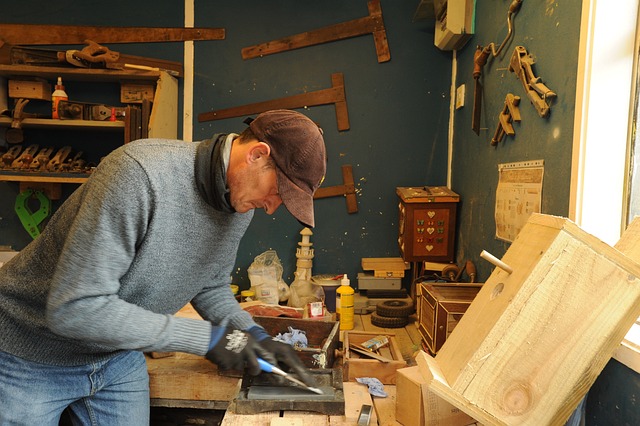Woodworking is a hobby that is both safe and enjoyable if you follow a simple set of safety rules. These rules are designed to be easy to remember and are mostly based on common sense.
Not adhering to the safety rules can result in severe injuries. The workshop is inappropriate for being careless, but rather serves as a space to acquire and incorporate proper safety practices, ultimately enhancing the enjoyment and amusement of woodworking.
1. Safety equipment should always be worn.
It is essential to remember this common sense rule: wearing ear protection is advantageous when using loud power tools like routers and surface planers. Equally important is wearing latex gloves during the application of finishes. When entering the shop, make sure to always prioritize wearing safety glasses.
Remember to put on appropriate attire.
To lessen the risk of accidents, it is important to avoid wearing baggy or loose clothing that can potentially become entangled in cutting machinery. Instead, wear clothing that is better suited for the woodworking environment and provides adequate protection. Additionally, it is essential to remove any dangling jewelry or metal accessories, such as chains or bracelets, before starting work. Another crucial measure is to refrain from using any substances or items that can impair your reaction time and judgement.
4. Power should be disconnected.
Always remember to first disconnect the power source itself prior to changing the blades or bits on your power tools. Additionally, ensure that the switch is off and there is no electricity being powered to the tool to avoid any potential malfunctions or accidental turning on. Lastly, it is recommended to use a single extension cord.
Utilizing just one heavy duty extension cord for all your power tools guarantees that you turn off the power for each tool. Having too many cords can lead to confusion and create a risk of tripping. Additionally, it is imperative to never use dull blades and bits.
It may seem obvious, but it is important to note that dull cutting tools can be dangerous. When tools are not sharp, they require more effort to cut and can potentially bind or kick back. On the other hand, using sharp bits and blades guarantees cleaner cuts. Additionally, it is recommended to check the stock for any existing metal.
Before sawing or making a cut, make sure that the piece of stock does not already have nails, screws, or other pieces of metal stuck in it.
Working against the cutter can cause damage to both the stock and the cutting head, as spinning blades and nails (and other pieces of metal) do not mix well together. Additionally, it can lead to stock kickback and injury. Therefore, it is important to consistently ensure the stock is clean, either by manually checking or utilizing a metal detector.
To ensure proper operation, most power tools are designed so that the direction in which a piece of wood is fed through the tool is opposite to the movement of the cutting head. Therefore, it is important to ensure that the blade or router bit cuts against the motion of the wood rather than with it.
Step 9: Remain sober and maintain mental clarity.
Whether it is your job or just a leisure activity, it is crucial to always acknowledge the inherent danger of woodworking. Therefore, it is essential to avoid using any potentially hazardous machinery if you have consumed substances that may hinder your judgment or response time. This includes refraining from alcohol consumption and being cautious of the effects that prescription drugs may have on your abilities.
10. Check Your Blades and Drill Bits are as Sharp as Possible
To ensure your safety when woodworking, it is important to use the most effective equipment available. While it may seem contradictory, using sharper blades and drill bits actually results in cleaner cuts with less airborne debris and reduced machine kick-back, even though they can be more dangerous in direct contact.
11. Double-Check for Nails and Other Metalwork Before Beginning
To ensure safety during woodworking, it is important to verify that you are only cutting wood.
When reshaping and refashioning reclaimed wood, be cautious as it may contain hidden nails and shrapnel. Before using a blade, carefully inspect the wood to avoid stray sparks and damaging the blade, which could lead to serious injury.
12. Respect the Blade
Regardless of your level of experience as a woodworker, it is essential to acknowledge the potential danger of the machinery and operate it correctly and safely. This involves consistently cutting square against the blade, instead of cutting from behind or at an angle.
Another important aspect is to avoid reaching over or around a running blade, as well as keeping your extremities away from the area directly beneath a drill head. Another crucial safety measure in woodworking is to have blade guards nearby and ensure they are always replaced after use, making sure to turn off the machine at the wall beforehand.
13. Do Away with Distractions
One way to ensure woodworking safety is to stay calm and focused, without any distractions. While it may not always be possible to avoid them, such as when a person unexpectedly enters your workshop on a business day, keeping a calm and focused mindset is essential.
To ensure maximum concentration while woodworking, it is advisable to take certain measures such as putting your mobile phone on silent mode without any vibration, and refraining from listening to music or engaging in discussions that can divert your attention. This is crucial as woodworking is inherently perilous, hence it is important to remain focused until your task is completed.
14. Keep your Breathing Zone Safe with At-Source Extraction
Our last method of ensuring safety while woodworking leads us back to the respiratory protection we mentioned in step one, which aligns with the core focus of our health and safety-oriented company.
